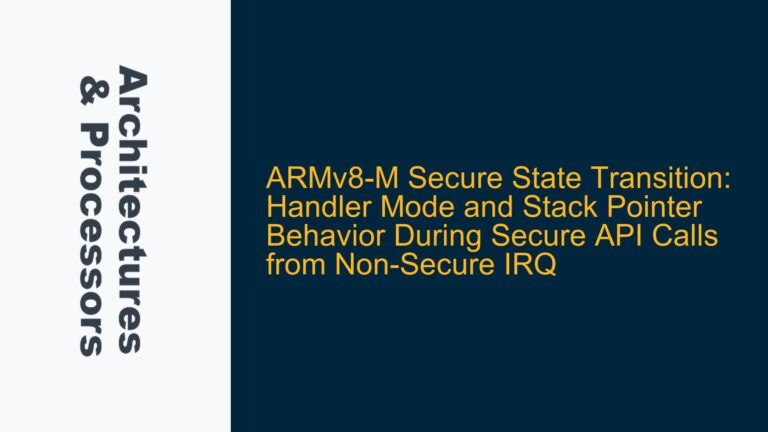ARM Cortex-A72 Core Frequency Locking for Functional Evaluation
When evaluating specific functions or performance characteristics on an ARM Cortex-A72 core, it is often necessary to lock the core frequency to a predefined value. This ensures consistent and repeatable results, especially when analyzing performance bottlenecks, power consumption, or thermal behavior. However, the ARM Cortex-A72, like many modern processors, is designed to dynamically adjust its frequency based on workload, thermal conditions, and power constraints. This dynamic frequency scaling is managed by the operating system and underlying hardware mechanisms, making it non-trivial to lock the frequency to a fixed value without modifying system behavior.
The challenge lies in bypassing the dynamic frequency scaling mechanisms while ensuring the system remains stable and functional. This requires a deep understanding of the ARM Cortex-A72 architecture, the Linux kernel’s CPU frequency management subsystem (CPUFreq), and the hardware registers involved in frequency control. Additionally, the process must be approached with caution, as forcing a fixed frequency can lead to thermal issues or even hardware damage if not managed properly.
Kernel-Level CPUFreq Subsystem and Dynamic Frequency Scaling
The ARM Cortex-A72 core relies on the Linux kernel’s CPUFreq subsystem to manage frequency scaling. The CPUFreq subsystem interacts with the hardware through performance management units (PMUs) and clock controllers to adjust the core frequency dynamically. This subsystem is designed to optimize performance and power efficiency by scaling the frequency up or down based on the current workload. However, for performance evaluation, this dynamic behavior introduces variability, making it difficult to isolate the impact of specific functions or optimizations.
The CPUFreq subsystem operates through governors, which are algorithms that decide how and when to change the frequency. Common governors include "performance," "powersave," and "ondemand." The "performance" governor sets the frequency to the maximum supported value, while the "powersave" governor sets it to the minimum. The "ondemand" governor adjusts the frequency based on the current CPU utilization. While these governors provide some control over frequency scaling, they do not allow for locking the frequency to an arbitrary value.
To achieve a fixed frequency, it is necessary to either modify the CPUFreq subsystem or bypass it entirely. This involves understanding the interaction between the kernel, the CPUFreq drivers, and the hardware registers that control the clock frequency. Additionally, the thermal management subsystem must be considered, as it can override frequency settings to prevent overheating.
Modifying Kernel Code and Hardware Registers for Fixed Frequency
To lock the ARM Cortex-A72 core frequency to a specific value, modifications to the Linux kernel and direct manipulation of hardware registers are required. This process involves several steps, including identifying the relevant kernel code, understanding the hardware clock control mechanisms, and implementing changes to enforce a fixed frequency.
The first step is to locate the CPUFreq driver responsible for managing the ARM Cortex-A72 core frequency. This driver interacts with the Performance Management Unit (PMU) and the clock controller to adjust the frequency. The driver typically exposes a set of sysfs interfaces that allow user-space tools to query and modify frequency settings. However, these interfaces do not provide direct access to the underlying hardware registers.
To enforce a fixed frequency, the CPUFreq driver must be modified to disable dynamic frequency scaling and set the frequency to the desired value. This involves identifying the code paths responsible for frequency adjustments and adding logic to bypass them. For example, the cpufreq_driver structure in the kernel contains function pointers for setting the frequency, which can be overridden to enforce a fixed value.
Once the kernel modifications are in place, the next step is to ensure that the thermal management subsystem does not override the fixed frequency. This may involve modifying the thermal driver or disabling thermal throttling altogether. However, this approach carries significant risks, as it can lead to overheating and hardware damage if the system is not properly monitored.
Finally, the hardware registers controlling the clock frequency must be configured to enforce the desired value. This requires detailed knowledge of the ARM Cortex-A72 architecture and the specific implementation of the clock controller. The registers typically include a frequency divider and a multiplier, which can be adjusted to set the core frequency. Care must be taken to ensure that the new frequency is within the supported range and does not violate the processor’s specifications.
Implementing Kernel Modifications and Validating Fixed Frequency
Implementing kernel modifications to lock the ARM Cortex-A72 core frequency involves several technical challenges and requires a systematic approach to ensure stability and correctness. The following steps outline the process of modifying the kernel, configuring hardware registers, and validating the fixed frequency.
The first step is to identify the relevant kernel source files and functions. The CPUFreq subsystem is implemented in the drivers/cpufreq directory of the Linux kernel source tree. The driver for the ARM Cortex-A72 core is typically located in a platform-specific subdirectory, such as drivers/cpufreq/arm_big_little.c or drivers/cpufreq/qcom-cpufreq.c. The driver exposes a set of functions for setting and querying the frequency, which can be overridden to enforce a fixed value.
Once the relevant code is identified, the next step is to modify the driver to disable dynamic frequency scaling. This involves adding logic to bypass the governor and set the frequency directly. For example, the target function in the cpufreq_driver structure can be modified to ignore the requested frequency and always return the desired fixed value. Additionally, the init function can be updated to set the initial frequency to the desired value.
After modifying the driver, the kernel must be recompiled and deployed to the target system. This process involves configuring the kernel build system, compiling the kernel image, and installing it on the target device. Once the modified kernel is running, the fixed frequency can be validated using tools such as cpufreq-info or by directly reading the hardware registers.
To ensure that the thermal management subsystem does not override the fixed frequency, the thermal driver must also be modified. This involves identifying the code paths responsible for thermal throttling and adding logic to disable them. Alternatively, the thermal thresholds can be adjusted to allow higher temperatures before throttling occurs. However, this approach requires careful monitoring to prevent overheating.
Finally, the hardware registers controlling the clock frequency must be configured to enforce the desired value. This involves writing to the appropriate registers using kernel code or a custom user-space tool. The registers typically include a frequency divider and a multiplier, which can be adjusted to set the core frequency. The new frequency must be validated using performance counters or other measurement tools to ensure that it is correctly applied.
Risks and Considerations for Fixed Frequency Operation
Locking the ARM Cortex-A72 core frequency to a fixed value carries several risks and considerations that must be addressed to ensure system stability and prevent hardware damage. The primary risks include thermal issues, power consumption, and potential violations of the processor’s specifications.
Thermal management is a critical consideration when operating at a fixed frequency. Modern processors rely on dynamic frequency scaling to manage heat generation and prevent overheating. By locking the frequency, the thermal management subsystem is effectively bypassed, increasing the risk of thermal throttling or even hardware damage. To mitigate this risk, the system must be carefully monitored, and additional cooling measures may be required.
Power consumption is another important factor to consider. Operating at a fixed frequency, especially a high one, can significantly increase power consumption, leading to reduced battery life in mobile devices or higher energy costs in embedded systems. This must be balanced against the need for consistent performance during evaluation.
Finally, the fixed frequency must be within the supported range for the ARM Cortex-A72 core. Exceeding the maximum supported frequency can lead to instability, data corruption, or hardware failure. Similarly, operating at a frequency below the minimum supported value can result in poor performance or unexpected behavior. The processor’s datasheet and technical reference manual should be consulted to determine the valid frequency range.
In conclusion, locking the ARM Cortex-A72 core frequency to a fixed value is a complex task that requires deep knowledge of the processor architecture, the Linux kernel, and the underlying hardware. While it can provide valuable insights during performance evaluation, it must be approached with caution to avoid thermal issues, power consumption problems, and hardware damage. By following a systematic approach and carefully considering the risks, it is possible to achieve a stable and reliable fixed frequency operation for functional evaluation.






